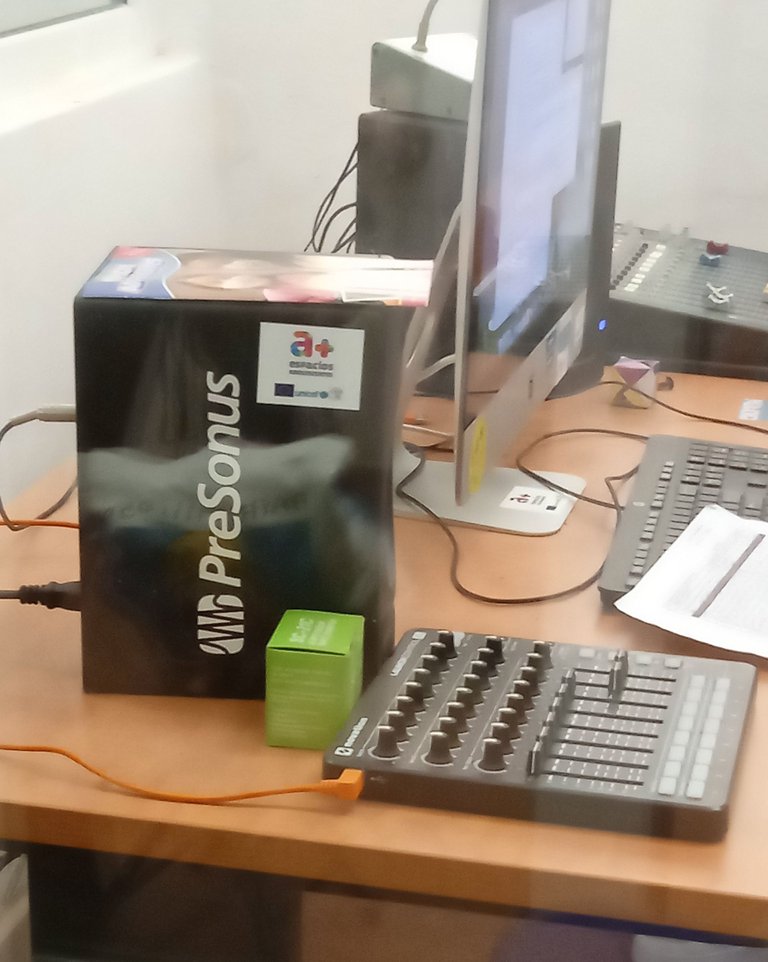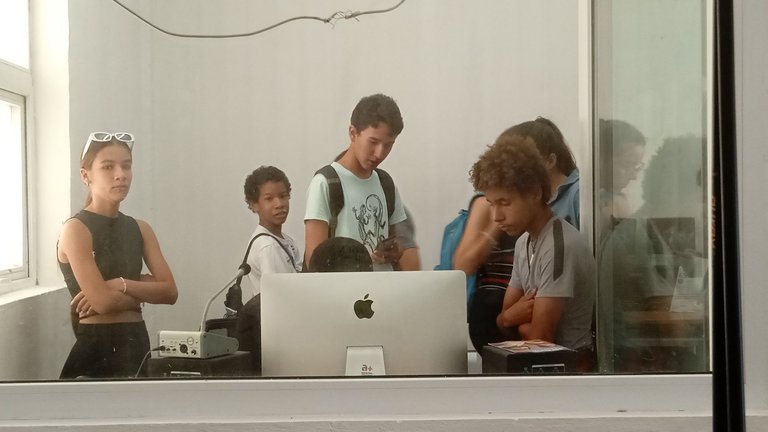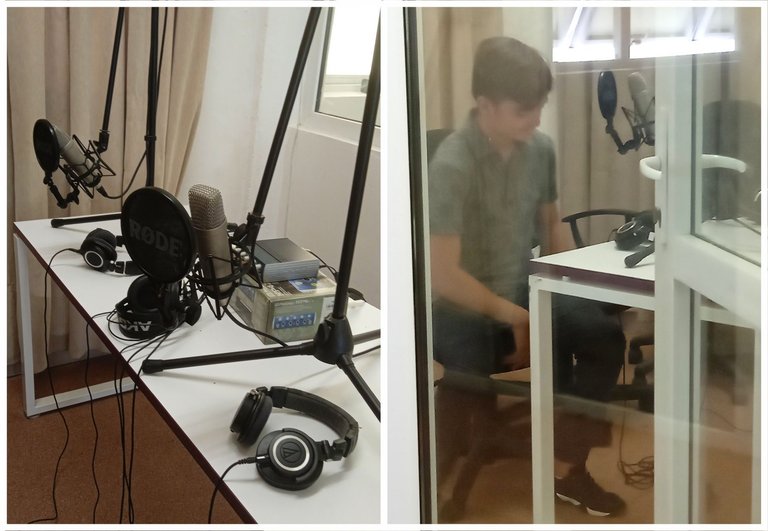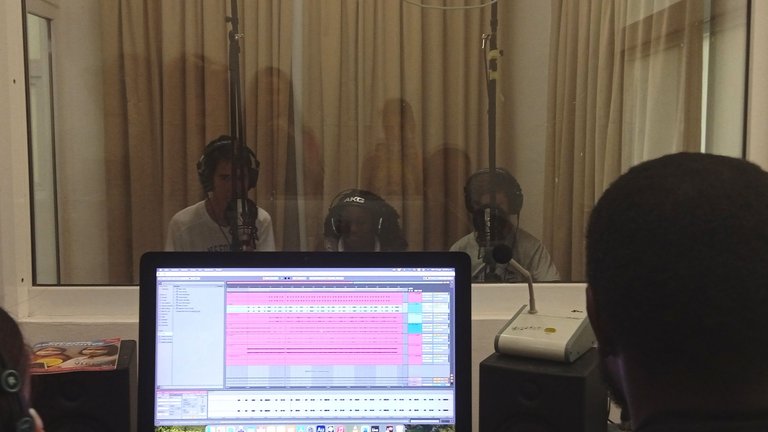¡Grabando! #2 - #3
This is already the third time I have entered the cabin and I never felt two days go by.
In these two days of the course I learned how to polish a recorded song. We all did the homework of the first day, curiously each one of us chose a song from a different artist or band, among them Måneskin, Queen, Buena Fe, The Weeknd, Papa Roach and in my case Calle 13. The teacher from a general point of view, not a personal one, characterized each artist and his style taking the song as an example and explained to us what were their minimum weaknesses in the field of mastering.
In some cases the artist focuses too much on his/her lyrics and gives too much importance to them, but fails to match the music, and sometimes the voice, emotionally with the ideas that are being expressed. In other cases where the artists have an aggressive style in their music, when we listen to a calmer song of theirs with soft lyrics and vocals the background music can confuse intentions. These are very specific to each artist and song.
After that initial talk the professor pushed us right into the operation of equalizers, used to modify frequency bands in sounds. He showed us three types of EQ's: parametric, graphic and Shelvin, all digital, installed in a music software from which I can't remember its name.
He sampled a practice song with all the instruments separated by tracks: kicks, vocals, bass and guitar. Each constituted the original recorded audio, without any effects or modifications, and the whole thing together sounded a bit dead.
One by one, the teacher modified their frequencies to not only make the beats more noticeable, but also to make our skin crawl. It is interesting how increasing the mid-range frequencies of the singer's voice makes it sound sharper, increasing the low frequencies makes it feel wider and stronger, and increasing the high frequencies creates an unconscious effect of aggressiveness. With the other instruments it works similarly but each one has a different range of frequencies, lower or wider than the range of a human voice; for example, with the bass, which only uses lows you will only need to modify these kind of frequency ranges to cause changes, but with a piano you will need to work with almost the whole spectrum of frequencies.
Once this process was finished, he unified everything again and played it. The difference was incredible.
This process ended today with the application of audio compressors, also digital. A compressor is a tool that is dedicated to balance the volume of a sound, increasing it in the low parts and decreasing it in the high parts by a desired number of decibels. It performs an automatic job following the values entered to each of its parameters for each of the instruments in the piece. It ended up faster than with the EQs, but it still greatly improved how the song felt to our ears.
Tomorrow is the mixing class, we will use a new song for practice and we will have the opportunity to try to master it completely on our own; I'm sure it will be very exciting.
Today at the end of the class we asked for permission to go in and see the mics up close. I took some pictures of the band and the booth.
Then two boys sat down and got hold of the microphone and headphones, started singing famous songs and a song they wrote themselves with a trap beat in the background that the teacher played for them.
It was so funny XD.
Well, until tomorrow!
Ya ha sido la tercera vez que entro a la cabina y nunca sentí dos días pasar.

En estos dos días del curso aprendí cómo se le saca brillo a una canción grabada. Todos hicimos la tarea del primer día, curiosamente cada uno llevó una canción de un artista o grupo distinto, entre ellos Måneskin, Queen, Buena Fe, The Weeknd, Papa Roach y en mi caso Calle 13. El profe desde un punto de vista general, no personal, caracterizó cada artista y su estilo tomando como ejemplo la canción y nos explicó cuáles eran sus mínimos puntos débiles en el campo de la masterización.
En algunos casos el artista se enfoca mucho en su letra y le da demasiada importancia, pero no logra que la música y ocasionalmente su voz no coincida emocionalmente con las ideas que expresa. En otros casos donde los artistas tienen un estilo agresivo en su música, cuando escuchamos un tema de ellos más calmado con una letra y voz suave la música de fondo puede llegar a confundir intenciones. Son cosas muy específicas para cada artista y canción.

Después de esa charla inicial el profesor nos lanzó de clavado al funcionamiento de los ecualizadores, utilizados para modificar bandas de frecuencia en los sonidos. Nos mostró tres tipos: los paramétricos, los gráficos y Shelvin, todos digitales, instalados en el software de música cuyo nombre no recuerdo.
Tomó como muestra una canción de práctica con todos los instrumentos separados por pistas: la voz, la batería, el bajo y la guitarra. Cada uno constituía el audio grabado original, sin ningún efecto o modificación, y se escuchaba un poco muerto en conjunto.
Uno por uno, el profe fue modificando sus frecuencias para además de hacer que se notaran más los beats llegaran a erizar nuestra piel. Es interesante como aumentando frecuencias de rango medio de la voz de ese cantante esta se nota más nítida, aumentando graves se siente más amplia y fuerte, y aumentando las altas se crea un efecto inconsciente de agresividad. Con los otros instrumentos funciona parecido pero cada uno presenta un rango distinto de frecuencias y menor que el de la voz. Por ejemplo, el bajo solo utiliza graves, así que hay que modificar frecuencias en este rango para causar cambios.
Escuchamos con atención el instrumento cada vez que él alteraba alguna frecuencia. Aquí los que se acomodaron para esperar el resultado final.

Ya terminado este proceso, volvió a unificar todo y le dio play. La diferencia fue increíble.
Este proceso terminó hoy con la aplicación de compresores de audio, igual digitales. Un compresor es una herramienta que se dedica a equilibrar el volumen de un sonido, aumentándolo en las partes bajas y disminuyéndolo en las altas por un deseado número de decibeles. Realizan un trabajo automático siguiendo los valores introducidos a cada uno de sus parámetros para cada uno de los instrumentos en la pieza. Terminó más rápido que con los ecualizadores, pero igualmente mejoró mucho cómo se sentía la canción a nuestros oídos.
Mañana es la clase de mezclas, usaremos una nueva canción de práctica y tendremos nosotros la oportunidad de intentar masterizarla por completo, solos; estoy segura de que será muy emocionante.
Hoy al acabar la clase pedimos permiso para entrar a ver los micrófonos de cerca. Hice unas fotos del grupo y la cabina.


Luego dos muchachos se sentaron y se apoderaron del micrófono y los cascos, empezaron a cantar temas famosos y una canción que ellos mismo escribieron con un beat de trap de fondo que el profe les puso.

Fue gracioso XD.
¡Mañana nos leemos!
All photos taken by me with my phone. English slightly supported by Deep L

Congratulations @anima-shot! You have completed the following achievement on the Hive blockchain And have been rewarded with New badge(s)
Your next target is to reach 2000 upvotes.
You can view your badges on your board and compare yourself to others in the Ranking
If you no longer want to receive notifications, reply to this comment with the word
STOPCheck out our last posts:
Thanks :D!
You've got this @anima-shot! Keep putting in the effort and you'll reach your target in no time.
Vaya, ¡qué divertido! Trucos y más trucos... 😄
Es genial que puedan conocer al detalle ese mundo porque así aprenderán a valorar en su justa medida la labor de los especialistas en sonido.
Siii aunque verdaderamente no pienso dedicarme a ello porque creo que destruiría canciones jajsjs...
Pero nada, ¡Siempre es bueno saber de todo y entender al menos lo básico del funcionamiento de cualquier cosa! El conocimiento no ocupa espacio.
Ahora que terminé el curso puedo asumir que en las canciones de reggaetón el ingeniero de sonido trabaja solo 5 minutos al día 🤣